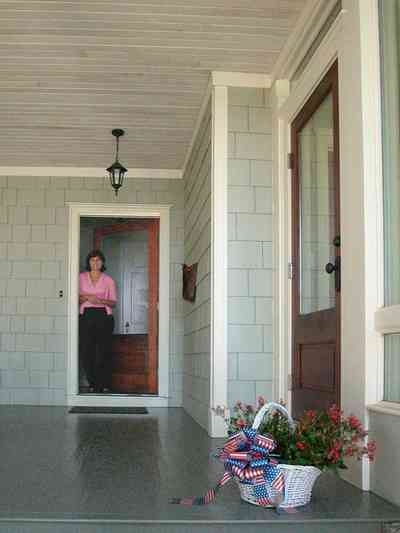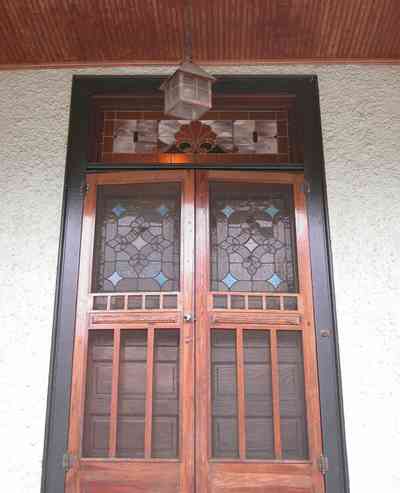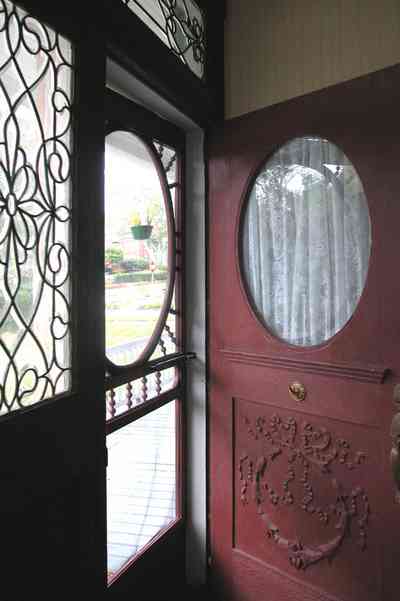-

-

Columns that are as wide as many of the surrounding trees flank the front door with its heavy beveled glass insets that have rippled under the weight of years. The spacious interior contains 18 rooms.
-

The auxillary front entrance is access for an apartment on the west side of the house.
-

Tricia Mangrum stands at the front door. The door on the right is for the office.
-

The front door tracery is enhanced with beveled glass.
-

The hipped roof is a distinguishing feature of the bungalow style which is particularly appropriate for hot climates, since warm air rises up into the high roof and leaves the rooms below cooler.
-

The Craftsman (or Arts and Crafts) movement in America developed as a reaction against the machine-made ornamental excess of the Victorian era. This was a back-to-nature movement, reflecting a desire to return to simpler times when craftsmen worked with their hands and took pride in detail. Structural detail and the use of good materials were prized over applied ornamentation. The bungalow has its roots in California, where this style was well suited to the warm climate. It then spread across the country to become one of the most common middle-class designs from 1910 to the 1930's.
-

-

-

-

-

-

The beveled glass at the entrance and over some of the large bay windows in the house are all original. The front door was originally beveled glass but it was destroyed during an "Animal House" party when aviators rented the house in the 1990s.
-

-

Stucco is the exterior finish of the home.
-

A circular staircase connects the guest quarters to the second floor residence.
-

The risers are wood that match the upstairs flooring material.
-

-

The kitchen is located on the west side of the second floor. It features a catering kitchen and wine cooler.
-

The appliances were imported from France.
-

-

-

-



 Columns that are as wide as many of the surrounding trees flank the front door with its heavy beveled glass insets that have rippled under the weight of years. The spacious interior contains 18 rooms.
Columns that are as wide as many of the surrounding trees flank the front door with its heavy beveled glass insets that have rippled under the weight of years. The spacious interior contains 18 rooms. The auxillary front entrance is access for an apartment on the west side of the house.
The auxillary front entrance is access for an apartment on the west side of the house. Tricia Mangrum stands at the front door. The door on the right is for the office.
Tricia Mangrum stands at the front door. The door on the right is for the office. The front door tracery is enhanced with beveled glass.
The front door tracery is enhanced with beveled glass. The hipped roof is a distinguishing feature of the bungalow style which is particularly appropriate for hot climates, since warm air rises up into the high roof and leaves the rooms below cooler.
The hipped roof is a distinguishing feature of the bungalow style which is particularly appropriate for hot climates, since warm air rises up into the high roof and leaves the rooms below cooler. The Craftsman (or Arts and Crafts) movement in America developed as a reaction against the machine-made ornamental excess of the Victorian era. This was a back-to-nature movement, reflecting a desire to return to simpler times when craftsmen worked with their hands and took pride in detail. Structural detail and the use of good materials were prized over applied ornamentation. The bungalow has its roots in California, where this style was well suited to the warm climate. It then spread across the country to become one of the most common middle-class designs from 1910 to the 1930's.
The Craftsman (or Arts and Crafts) movement in America developed as a reaction against the machine-made ornamental excess of the Victorian era. This was a back-to-nature movement, reflecting a desire to return to simpler times when craftsmen worked with their hands and took pride in detail. Structural detail and the use of good materials were prized over applied ornamentation. The bungalow has its roots in California, where this style was well suited to the warm climate. It then spread across the country to become one of the most common middle-class designs from 1910 to the 1930's.




 The beveled glass at the entrance and over some of the large bay windows in the house are all original. The front door was originally beveled glass but it was destroyed during an "Animal House" party when aviators rented the house in the 1990s.
The beveled glass at the entrance and over some of the large bay windows in the house are all original. The front door was originally beveled glass but it was destroyed during an "Animal House" party when aviators rented the house in the 1990s.
 Stucco is the exterior finish of the home.
Stucco is the exterior finish of the home. A circular staircase connects the guest quarters to the second floor residence.
A circular staircase connects the guest quarters to the second floor residence. The risers are wood that match the upstairs flooring material.
The risers are wood that match the upstairs flooring material.
 The kitchen is located on the west side of the second floor. It features a catering kitchen and wine cooler.
The kitchen is located on the west side of the second floor. It features a catering kitchen and wine cooler. The appliances were imported from France.
The appliances were imported from France.



 One Tank of Gas
One Tank of Gas